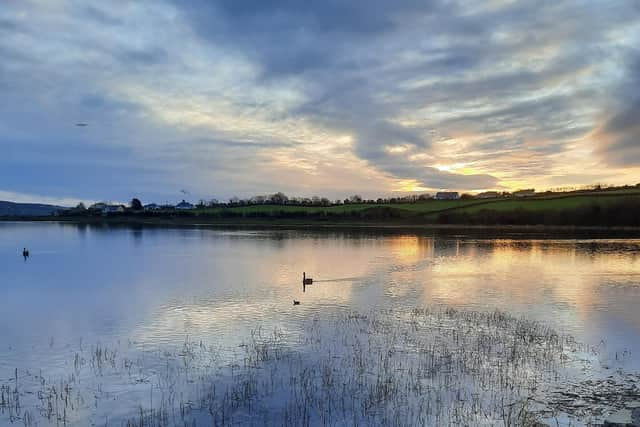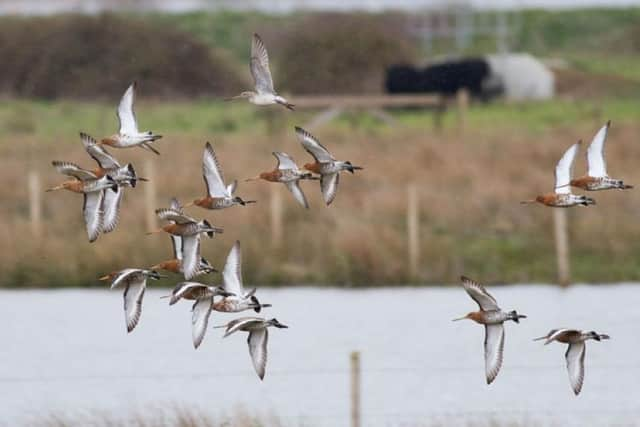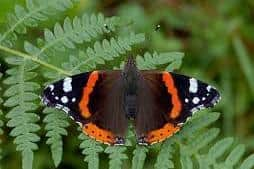Inch walk – A journey through space and time
and live on Freeview channel 276
It was just before the autumn solstice, a time between summer and winter when nature prepares itself for the inevitable changes in daytime and weather.
We began our walk at Pump House car park, directly opposite Burt Chapel.
Advertisement
Hide AdAdvertisement
Hide AdMoving in a clockwise direction we walked and talked about what we saw and heard around us.


As with any walk in Ireland, we were travelling with the ghosts of the past.
These included Mesolithic hunters, bronze age fort builders, high kings of Ireland, warring clan chiefs, Plantation invaders, railway builders and visionary farmers.
Ireland’s first inhabitants, the Mesolithic hunter gatherers, left their mark.
Advertisement
Hide AdAdvertisement
Hide AdThere is a seemingly inconspicuous ridge along the route, (just after crossing the Farland Bank).


Archaeologists have established that it not a natural but the remains of a manmade midden.
The ridge is made up of thousands of seashells, the discarded litter of Ireland’s first fast food joint.
Beginning 8,000 years ago and continuing for hundreds of years, Mesolithic people had regular summer picnics on this spot.


Advertisement
Hide AdAdvertisement
Hide AdThey ate the shellfish which they had found in the mud flats in front of them.
They tossed the shells behind them to form the ridge.
No doubt it was not an entirely relaxed meal in that bears and wolves were looking for an opportunity to eat the diners and spoil the fun.
Within sight of the lake there are a number of fortifications.
Grianan Mountain was the site of a bronze age ring fort.
More obvious on top of the mountain is Grianan of Aileach Fort itself.
Advertisement
Hide AdAdvertisement
Hide AdBuilt by the Úi Néill dynasty around 800 AD. It was abandoned when the McLaughlin chief was defeated by the Muirchertach Ua Briain the king of Munster around 1,000 AD.
The area around the lake is part of the dividing line between the rival Cenél nEogain and Cenél Conaill.
Eogain and Conall were the successors of Niall of the Nine Hostages, Niall Noigiallach.
Grianan Fort, Burt Castle and the O’Doherty Tower on Inch are all boundary markers between these perennial rivals.
Advertisement
Hide AdAdvertisement
Hide AdThis ancient quarrel was brought to an abrupt end with the beginning of the Plantation in 1600.
Only the section of the walk on Inch Island is on natural ground.
The rest of the walk is formed on earthworks constructed in the late 1800s to facilitate land drainage and railway construction.
Advertisement
Hide AdAdvertisement
Hide AdThe line from Derry branched at Tooban Junction with one line going to Burtonport via Letterkenny, the other going to Carndonagh via Buncrana.
A land drainage scheme using the railway embankments with the Inch Causeway and the Farland bank was begun around the same time.
Inch had been a tidal island up to the construction of the causeway when it became permanently attached to the rest of Donegal.
Previous to that time it was possible to reach the island at low tide. Inch lake was formed because the tide could no longer sweep around the island.
Advertisement
Hide AdAdvertisement
Hide AdThe drainage scheme was not completed until the 1960s when Daniel McDonald, an industrialist who owned the BSR factory in Derry, amalgamated eighteen small farms to create the 3,000 acre Grianan Estate Farm.
Human history is characterized by change.
The Mesolithic hunters were followed by Neolithic farmers.
Their stone tools were replaced the more advanced technology of bronze and iron.
The builders of the Grainan of Aileach did not envisage its downfall.
Advertisement
Hide AdAdvertisement
Hide AdThe ancient rivalry between the Cinél Eoghain and Cenél Conaill had no relevance after the Plantation.
All the effort to build the railways lasted less than one hundred years.
By contrast we think of nature as being unchanging. The seasons follow one another with predictable regularity.
One sign of this fixed pattern was the sight we saw just as we began our walk.
It was a flock of a hundred black tailed godwits.
Advertisement
Hide AdAdvertisement
Hide AdThey are large birds, only slightly smaller than the more familiar curlew.
Their long legs and beaks are typical of wading birds that search for food in the mudflats and damp fields around the lake.
They seemed excited perhaps because they had just completed a long and hazardous journey across the Atlantic from their summer breeding grounds in Iceland.
They whirled directly above our heads, landed in the fields nearby and repeated the same aerial dance seemingly for our entertainment.
Advertisement
Hide AdAdvertisement
Hide AdThey were the first of a huge number of wildfowl which, later in the Autumn, will make their way to Inch Lake from Iceland, Greenland, Canada, Alaska and northern Europe.
Huge flocks of swans, geese and ducks and waders will arrive to enjoy what the area has to offer in terms of climate, food and shelter.
Some will stay throughout the winter, others will transfer to other wetlands in Ireland or carry on south to Southern Europe and the west coast of Africa.
Advertisement
Hide AdAdvertisement
Hide AdThese mammoth journeys have been happening since the last ice age 20,000 years ago.
Inch Lake is of enormous importance internationally as a winter residence and staging post for the annual migration of huge flocks of swans, geese and ducks and waders.
Making it one of the wonders of the natural world as important as any more famous location we see nightly on our television screens.
It is no distance for people from Derry and Donegal to enjoy their own local safari at Inch Lake without the problems of international travel.
Advertisement
Hide AdAdvertisement
Hide AdWe continued our walk over the path on top of the Derry to Buncrana rail track.
We saw two Red Admirals, Ireland’s most spectacular butterflies.
Each year these gorgeous creatures fly into Ireland from Southern Europe.
They feed on nettles and lay their eggs beneath the same plant. In the autumn they feed on the flowers of the ivy bush.
Advertisement
Hide AdAdvertisement
Hide AdThe two we saw were possibly building up their strength to return south again.
Turning a bend in the path, we surprised a buzzard perched on a fence post.
It flew leisurely away, gained height and begun circling around the lake making its characteristic cat-like calls.
Fifty years ago the buzzard was very rare but after legislation which reduced the poisoning of carcasses, the buzzard has thrived.
Advertisement
Hide AdAdvertisement
Hide AdFrom being a rarity, it is now Ireland’s most common bird of prey.
Much like a small eagle in appearance, the buzzard has the habits of a vulture eating all manner of carrion.
This made it particularly susceptible to poisoning.
Throughout our walk we copied the Mesolithic hunter gatherers picking apples and eating blackberries.
Advertisement
Hide AdAdvertisement
Hide AdInevitably that famous line of Keates came to mind: ‘Season of mist and mellow fruitfulness’.
Pádraig – one of my talking companions as we set off around Inch Lake – was particularly interested in the bunches of berries hanging from the elder bushes.
We stuffed our harvest into a plastic bag. Pádraig arrived at my house a few days later with the gift of a small bottle.
Using the berries and adding spices, he had made an elderberry syrup which he assured me would protect against the rigours of the oncoming winter with its inevitable colds and flu.
Advertisement
Hide AdAdvertisement
Hide AdOur walk had been made possible by those who had invested time and money into the creation of the path.
The work of the labourers who built the original railway had not been in vain.
As a means of transport it has been long closed but its recycling as an amenity for exercise and recreation is something that will be enjoyed for generations to come.
Similar schemes using old railway lines have been opened in recent years.
Advertisement
Hide AdAdvertisement
Hide AdMost notably in Mayo where it is possible to walk or cycle 27 miles from Westport to Achill Island on the Western Greenway.
We had all enjoyed our walk and talk but inevitably we live in times when there are worries about the state of the natural world.
The buzzard’s recovery is the exception to the serious decline in birdlife worldwide.
In the same week as our walk, a report by Birdlife International stated that nearly half of the world’s birds were in decline.
Advertisement
Hide AdAdvertisement
Hide AdOnly six per cent of the world’s species were increasing in numbers.
One in eight species were in danger of extinction. This decline is due to a number of reasons.
One of the most important is habitat destruction.
It is hard to assess whether the drainage work around the lake contributed to this decline as the formation of the lake is in many ways a positive factor.
However, in general drainage schemes affect wildfowl very badly depriving them of food, safety and a place to nest.
Advertisement
Hide AdAdvertisement
Hide AdWe were lucky to see the red admiral butterfly not least because insect decline is a worldwide factor which has a negative impact on the many birds that feed on them.
We may think of nature as being unchanging, something that can always be relied upon not only for pleasure and relaxation but as something maintaining our very existence.
Unfortunately this is not the case. In other visits to the lake, was delighted to see little egrets and on one occasion the much larger great egret.
Two really beautiful and exotic birds, it is unfortunate that the arrival of such wonderful creatures should be accompanied by deep unease.
Advertisement
Hide AdAdvertisement
Hide AdThe presence of these birds, whose habitat until recently was southern Europe, is yet another indication of global warming and all its attendant horrors: disruption of wildlife, millions of starving people as drought rages in the Horn of Africa, devastating floods in Pakistan and super strength hurricanes in Florida.
The best time to visit the lake is around Hallowe’en.
The huge flocks of whooper swans, graylag geese, white fronted geese and a huge variety of dusks and waders will gather at the lake and the surrounding fields after their migration from the Arctic.
We three ould codgers – Pádraig, Jamesie and I – enjoyed the walk but it is more important that children are brought to the lake.
Stimulating an interest in wildlife is a first step to encourage children into becoming guardians of our heritage and environment.
A safari to Inch Lake would be a good step on this lifetime journey.
Comment Guidelines
National World encourages reader discussion on our stories. User feedback, insights and back-and-forth exchanges add a rich layer of context to reporting. Please review our Community Guidelines before commenting.
